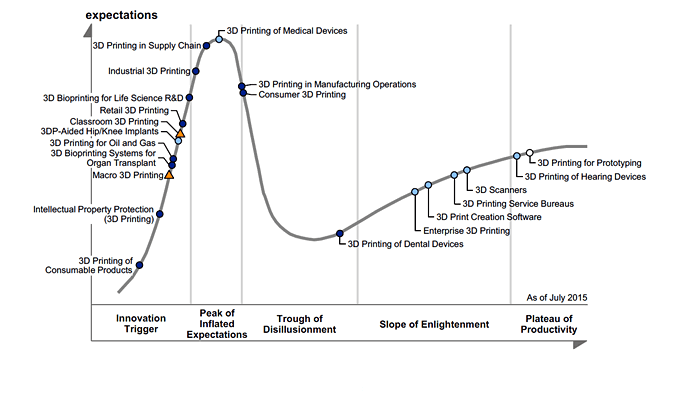3D printing does have a relationship with the internet but it’s not analogous, thinks All3DP’s columnist Rachel Park. Here’s why.
For the last three and a half years, 3D printing has regularly been compared with the Internet – usually in terms of size and reach. “3D Printing will be bigger than the Internet” is a reoccurring headline across a range of media types, or, from the slightly more cautious “Will 3D Printing be as big as the Internet?”
The Short Answer is No! No, it Will Not
The 3D printing and Internet analogy has always irritated me because I believe it is largely based on the hype around 3D printing that ballooned over recent years and it is little more than a headline grabber.

Looking back, the first comparison of 3D printing to the Internet I can find came from Avi Reichental, then CEO of 3D Systems. He gave an interview to Peter Marsh, a correspondent for the Financial Times (FT) in July 2012. The ulterior motives for the CEO of a 3D printing company with a definitive consumer strategy to push 3D printing as the next big consumer technology are obvious, notwithstanding they were wrong — at least the timing of it was wrong.
To get an idea of how misguided, his personal beliefs (specified) in these analogies were in 2012. In the interview, Reichental states that he thinks 3D printing will be “as big as the Steam Engine / Computer / Internet was in its day.” Steam engine aside, these technologies are still “in their day” with huge growth ongoing. Move past the analogies though and the point Reichental is making is that “3D printing will be the next disruptive technology that is going to change everything.” Specifically, he was saying it’s going to “change how we learn, how we create and how we manufacture.” This is where I agree — it is and will continue to change how we learn, create and make — but not “everything.” Very far from it and that’s where reality — and truth — has to kick in.
It’s a Myth That has Evolved into a Weird Collective Reality
To be fair, while Avi was the first, he is certainly not the only one to harp on about 3D printing being bigger that the Internet — the analogy has been used by other notable industry leaders and, of course, the media ever since. It’s a myth that has evolved into a weird collective reality.
Except it’s not real.
There are a number of reasons that I can identify to support this view that 3D printing is not as “big” as the Internet — whether you quantify big in terms of size and reach or revenue. The dominant one is simply just a consideration of my own, personal use of the Internet, which, I am confident, is reflective of most people with access to it. For better or worse, today it permeates my day-to-day activities from morning until night whether at work, rest or play. Here’s a list I came up with in under 5 minutes — I don’t doubt you could add to it:
- Work – research and communications.
- Personal communications
- Banking
- Shopping — groceries / clothes / homewares / gifts / toys / DIY / gadgets & electronics
- Take out insurance — home / car / pet
- Tax my car (which reminds me, due this month)
- Register energy meter readings
- Watch TV
- Book Holidays
- Flight Check In and Updates
- Route finder and travel directions
- Gaming (mostly my husband and son but I have been known to join in)
- Social Media (sometimes excessively)
- Music – downloading and listening
- Help kids with their homework.
Even despite my interest in 3D printing technology, both professionally and personally, and the amount of time I spend reading and writing about it; I do not envisage a day when the activity of 3D printing will penetrate my life to the degree the Internet does today.
The thing is, the (continued) growth of the Internet has never been and will never be dependent on 3D printing. The reverse is not true though — the Internet enables the growth of the 3D printing industry, particularly for consumer facing applications via 3rd parties, but also for industrial applications.
The Analogy is Wrong
Important to stress here, I am not disputing the growth of the 3D printing industry, only the analogies of growth with the Internet. I do believe 3D printing will continue to grow and be disruptive on many fronts for legitimate reasons. Through the end of last year and this first month of 2016, there have been plenty of forecasts that point in this direction. I’ve cherry picked a couple, but as ever, they vary wildly, and almost all have vested interests. That said, regardless of the research sources, they all project significant and continued growth, which is the main point to take away here:

Across the full spectrum of platforms, from desktop to industrial manufacturing scale, Gartner’s 3D printer market forecast estimates that shipments of 3D printers will grow at a massive compound annual growth rate (CAGR) of 121.3% through 2019. This is an over all figure based on units and revenue but says nothing of application and understanding. More insightful, albeit more limited in scope, I believe, is a more recent blog post by Gartner correspondent Pete Basilier reporting on a 3D printing round table at CES in Las Vegas at the beginning of the month, which highlighted virtual inventory as a huge growth application for 3D printing. I believe this is so, but even here, vested interests permeate forecasts. Present were Alan Amling, VP of Logistics and Distribution at UPS, who, ironically enough “likened the current situation to 1995 and the potential of the Internet,” and Rick Smith, Co-Founder of CloudDDM, who believes that virtual inventory could be “the first killer app for 3D printing.”
Just a few days ago, IDC (International Data Corporation) published its Worldwide Semiannual 3D Printing Spending Guide, which predicts that global spending on 3D printing will grow at a 27% CAGR from nearly $11 billion in 2015 to $26.7 billion in 2019.
“3D printing has been a mainstay in specialized discrete manufacturing markets like automotive and aerospace for many years. However, in just the past three years, lower-priced 3D printers and affordable materials have dramatically widened the market for 3D printing to now enable consumer, education, healthcare and additional manufacturing markets. That said, 3D printing availability doesn’t translate similarly across industries. Vendors and service providers need to understand how differences in use cases, materials cost, and end customer expectation are uniquely shaping each market,” said Christopher Chute, Vice President, Consumer Insights and Analysis Group.
“The technologies that enable 3D printing continue to develop and expand in nearly every direction,” added Tim Greene, Research Director, Hardcopy Solutions. “These technologies can help deliver larger, more accurate, and more solidly built models in a fraction of the time.”
According to Keith Kmetz, Program Vice President of IDC’s Imaging, Printing and Document Solutions research: “IDC’s 3D printing research indicates that the 3D printer market is primed and ready for greater mainstream adoption. There is strong appeal for this technology across several markets, and regions.”
Thus, IDC expects that key regions and vertical industries will drive this high rate of growth and provide a transformative effect on how previously mass-produced goods can now be customized for individual needs and requirements. The firm further expects that Asia/Pacific, the United States, and Western Europe will grow their aggregate share of global spending from 59.2% in 2014 to 70% by 2019, as China in particular becomes a leading market for 3D printing hardware and services.
Meanwhile, according to the Consumer Technology Association (CTA), which released its semi-annual industry report, U.S. Consumer Technology Sales and Forecasts to coincide with its CES show and predicts 3D printing will be one of the major drivers of growth in the tech industry with forecast revenue increases of 38%, and a total revenue of $152 million. Further: “3D printer sales are projected to increase by 64%, with an estimated 178 million printers being sold in the United States.”
And just for fun: Technavio’s research analyst predicts the global 3D printer market to register a CAGR of more than 41% during the forecast period (2016 – 2020). Based on comments like this … “3D printing capabilities have no limits as there are many areas yet to explore, and manufacturers are extending to new applications such as the introduction of 3D print sex toys.”
The Growth is Real and that it will Continue
In all seriousness, though —the growth is real and that it will continue. I don’t hold this view because of what analysts say, but because of the primary and secondary evidence, I am seeing of vertical manufacturing sectors embracing 3D printing and additive manufacturing more emphatically than ever before. The automotive, aerospace, medical device & healthcare and national defense equipment sectors are among those leading the way. Meanwhile, individual creative makers and small start-ups are also making different grades of additive technology work for them — which also contribute to steady overall market growth.
While the consumer 3D printer has been knocked back, and rightly so, I do also still believe that 3D printing does belong in the consumer age, which is seeing a distinct move away from mass produced products. Customisation — the ability to create things based on our individuality — and sustainability both incur a premium, but they are premiums more and more of us our willing to pay for via a 3rd party. This is real, this is happening now and 3D printing will increasingly be an enabler for this.
There is plenty of 3D printing reality to get excited about now, without resorting to ridiculous headlines about the Internet.
License: The text of "3D Printing is a Big Deal But Comparing it to The Internet Is Not Helpful" by All3DP is licensed under a Creative Commons Attribution 4.0 International License.